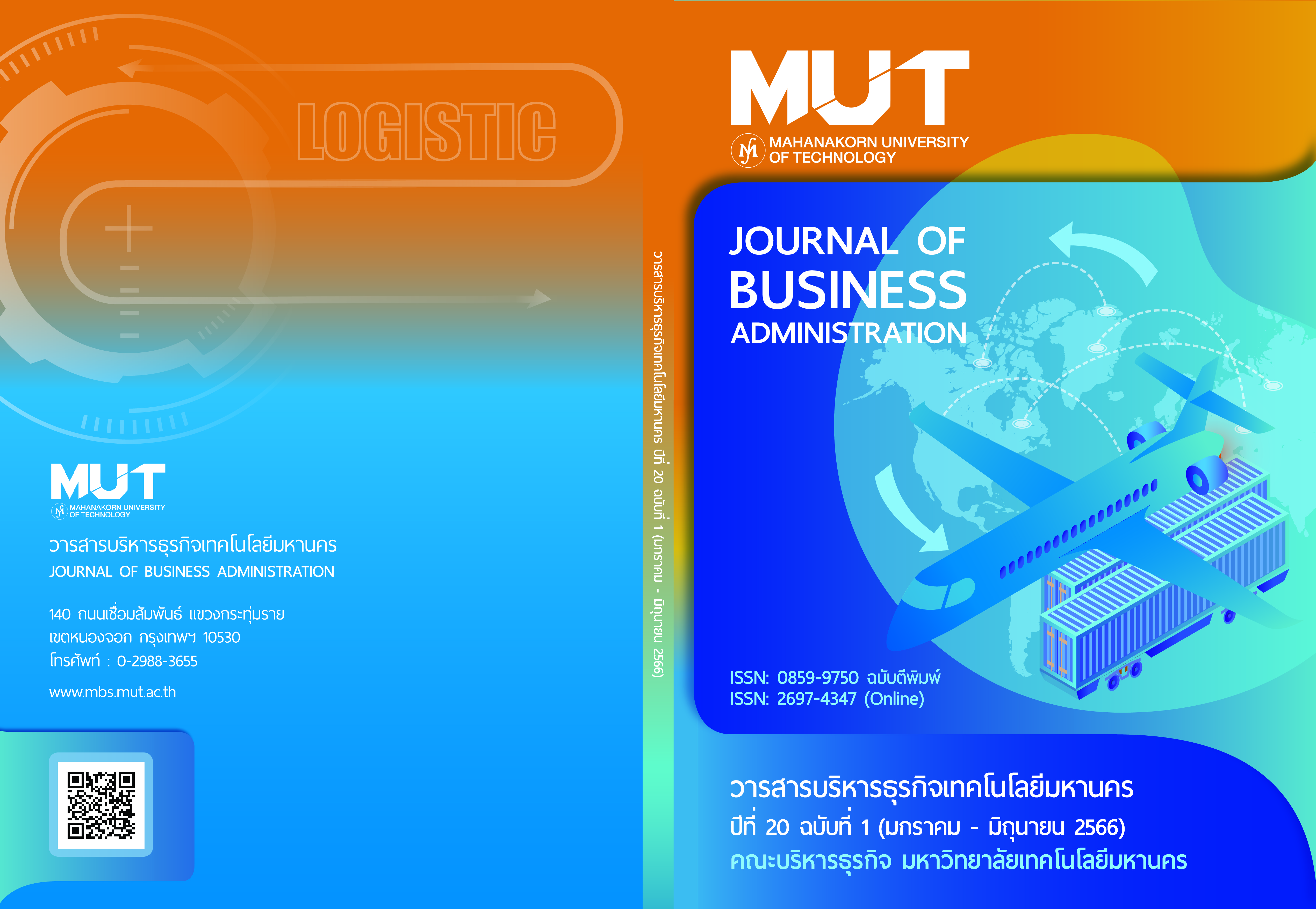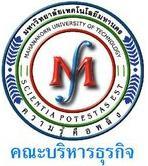Word of Mouth’s Structural Equation Modeling of Customer Satisfaction toward Marketing Factors of Lobo Condiment Product
Keywords:
Lobo condiment product, Marketing factors, Word of mouthAbstract
The purpose of this research is to study customer satisfaction toward marketing factors of Lobo condiment product via Lobo’s LINE Official Account (Lobo’s LINE OA) which affecting customer’s word of mouth. In this research, totally 400 samples were selected from customers who purchased Lobo condiment product via Lobo’s LINE OA. A statistical methodology, technique of Structural equation modeling (SEM) was used to analyze data. The-first-order and the-second-order Confirmatory factor analysis (CFA) had been used to test relationship between variables. After adjusted the second-order CFA model, the respecified model was fit the data well. Therefore, the research results revealed that customer satisfaction toward marketing factors, product, price, place, promotion, process, safety, information and service of Lobo condiment product had an effect to word of mouth.
The first-order CFA model was adjusted three times. The final of first-order CFA model revealed Chi-square value = 373.924, DF = 266, P-value 0.000, CMIN/DF =1.406, GFI = 0.935, CFI = 0.988 and RMSEA = 0.032. The results showed that customer satisfied the most three marketing factors which were (1) Information3 “Providing link of product line information” with factor loading was 0.86. (2) Pomotion2 “Free premium” and (3) Service4 “Polite respond and building trust to customer”. Factor loading of these latter two factors had been exhibited the same value of 0.85. The final of second-order CFA model was adjusted two times and revealed Chi-square value = 417.690, DF = 2641, P-value 0.000, CMIN/DF =1.582, GFI = 0.923, CFI = 0.981 and RMSEA = 0.038. The analyzing result revealed that the marketing factor which mostly affected customer’s word of mouth was Safety with factor loading was 1.00. Meanwhile, Information and Process had an effect on the other in the second priority. The factor loading revealed the same value at 0.98.
References
Baumgartner, H. and Homburg, C. 1996. Applications of structural equation modeling in
marketing and consumer research: A review. International journal of research in marketing. Vol. 13. Issue 2. 139 – 161.
Belew, S. and Elad, J. 2017. Starting an Online Business All-in-one for Dummies. 5th ed. New Jersey: John Wiley & Sons.
Bentler, P.M. 1990. Comparative fit indexes in structural models. Psychological Bulletin. Vol. 107. 238 – 246.
Bentler, P.M. 1992. On the fit of models to covariances and methodology to the Bulletin.
Psychological Buletin. Vol. 112. 3. 400 – 404.
Brown, T.A. 2015. Confirmatory factor analysis for applied research. 2nd ed. New
York: The Guilford press.
Browne, M.W. and Cudeck, R. 1993. Alternative ways of assessing model fit. In: K.a. Bollen
and J.S. Long (eds.) Testing structural equation models. Newbury Park. CA: Sage Publications, Inc.
Buttle, F. and Maklan, S. 2015. Customer Relationship Management : Concept and
Technologies. 3rd ed. New York: Routledge.
Byrne, Barbara M. 2010. Structural Equation Modeling with AMOS: Basic Concepts,
Applications, and Programming. 2nd ed. New York: Routledge.
Chaffey, D. and Ellis-chadwick, F. 2016. Digital Marketing: Strategy, Implementation and
Practice. 6th ed. UK: Pearson.
Chaffey, D. 2015. Digital Business and E-Commerce Management: Strategy,
implementation and practice. 3rd ed. London: Pearson.
Cheung, C.M.K., Chan, G. W. W. and Limayem, M. 2005. A Critical Review of Online
Consumer Behaviour: Empirical Research. Journal of Electronic Commerce in
Organisations. Vol. 3 No. 4. 1 – 19.
Electronic Transactions Development Agency. 2021. Retrieved September 17, 2022
from https://www.etda.or.th/th/pr-news/ETDA-released-IUB-2021.aspx
Electronic Transactions Development Agency. 2019. Value of e-commerce Survey in
Thailand 2019. Retrieved September 17, 2022 from https://shorturl.asia/S8JBh
Fan, X., Thompson, B. and Wang, L. 1999. Effects of sample size, estimation methods, and
model specification on structural equation modeling fit indexes. Structural Equation
Modeling: A Multidisciplinary Journal. Vol. 6 Issue 1. 56 – 83.
Investopedia. 2022. Word-of-Mouth Marketing: Meaning and Uses in Business. Retrieved
May 27, 2023 from https://www.investopedia.com/terms/w/word-of-mouth-marketing.asp#toc-benefits-of-word-of-mouth-marketing
Kaufman, I. and Horton, C. 2015. Digital Marketing: Integrating Strategy and Tactics with
Values. A Guidebook for Executives, Managers & Students. New York: Routledge.
Kotler, P. and Keller, K. L. 2012. Marketing Management. 14th ed. USA: Pearson Education.
Kundu, S. and Rajan, CR.S. 2017. Word of mouth: A literature review. International Journal
of Economics & Management Sciences. Volume 6 Issue 6.
Polprateep, K. and Sripathum, M. 2017. Marketing mix and marketing communication tools
factors affecting to Honda Motorcycle purchasing decision of consumer in
Ladkrabang Industrial Estate, Bangkok Metropolitan. Proceeding of Panyapiwat
National Academic Conference 7th. A12 - A34.
Rossmann, A., Ranjan, K.R. and Sugathan, P. 2016. Drivers of User Engagement in e WOM
Communication. Journal of Service Marketing. Vol. 30. No. 5. 541 – 553.
Roy, SJ., Lassar, WM. and Butaney, GT. 2014. The mediating impact of stickiness and loyalty on word-of-mouth promotion of retail websites. European Journal of Marketing. 48: 1828 – 1849.
SendPluse. 2023. Word of Mouth Marketing. Retrieved May 28, 2023 from
https://sendpulse.com/support/glossary/word-of-mouth-marketing
Shi, W., Tang, L., Zhang, X., Gao, Y. and Zhu, Y. 2016. How does word of mouth affect customer satisfaction? Journal of Business & Industrial Marketing. 31: 393 – 403.
Strauss, J. and Frost, R. 2016. E-Marketing. 7th ed. New York: Routledge.
Sweeney, J.C., Soutar, G.N. and Mazzarol, T. 2008. Factors influencing word of mouth
effectiveness: receiver perspectives. European: Journal of Marketing. Vol. 42. (3/4): 334 – 364.
Sweeney, B. 2022. Digital Marketing Quick Start Guide. Clydebankmedia.
Tan, F. and Sutherland, P. 2004. Online Consumer trust: A Multi-dimensional Model. Journal
of Electronic Commerce in Organisations. Vol. 2. 41 – 59.
Yamane, T. 1973. Statistics: An Introductory Analysis. 3rd Ed. New York: Harper and Row
Publications.
Zendesk Blog. 2023. What is customer satisfaction? Definition + Importance. Retrieved
May 28, 2023 from https://www.zendesk.com/blog/3-steps-achieving-customer-satisfaction-Loyalty
Additional Files
Published
Issue
Section
License

This work is licensed under a Creative Commons Attribution-NonCommercial-NoDerivatives 4.0 International License.
ข้อความ ข้อคิดเห็น ข้อมูล เนื้อหา รูปภาพ แผนภูมิ แผนผัง เป็นต้น ที่ปรากฏและแสดงในบทความต่างๆ ในวารสารบริหารธุรกิจเทคโนโลยีมหานคร ถือเป็นความรับผิดชอบโดยตรงของผู้เขียนบทความนั้นๆ มิใช่เป็นความรับผิดชอบใดๆ ของวารสารบริหารธุรกิจเทคโนโลยีมหานคร และมหาวิทยาลัยเทคโนโลยีมหานคร
บทความที่ตีพิมพ์ในวารสารบริหารธุรกิจเทคโนโลยีมหานคร ถือเป็นลิขสิทธิ์เฉพาะของคณะบริหารธุรกิจ มหาวิทยาลัยเทคโนโลยีมหานคร หากบุคคลหรือหน่วยงานใดต้องการนำทั้งหมดหรือส่วนใดส่วนหนึ่งไปเผยแพร่ต่อหรือเพื่อกระทำการใดๆ จะต้องได้รับการอนุญาตเป็นลายลักษณ์อักษรจากคณะบริหารธุรกิจ มหาวิทยาลัยเทคโนโลยีมหานครก่อนเท่านั้น


